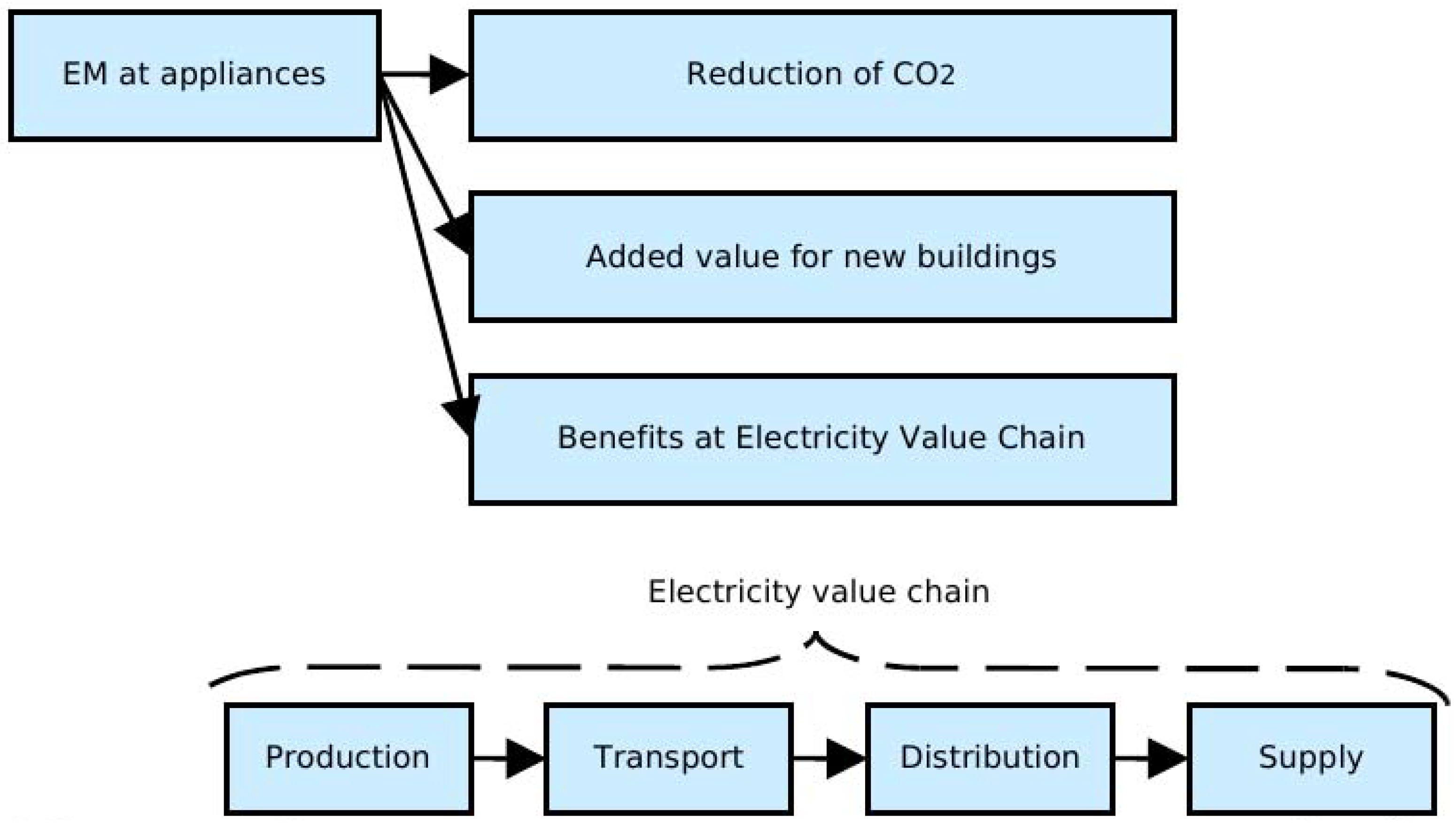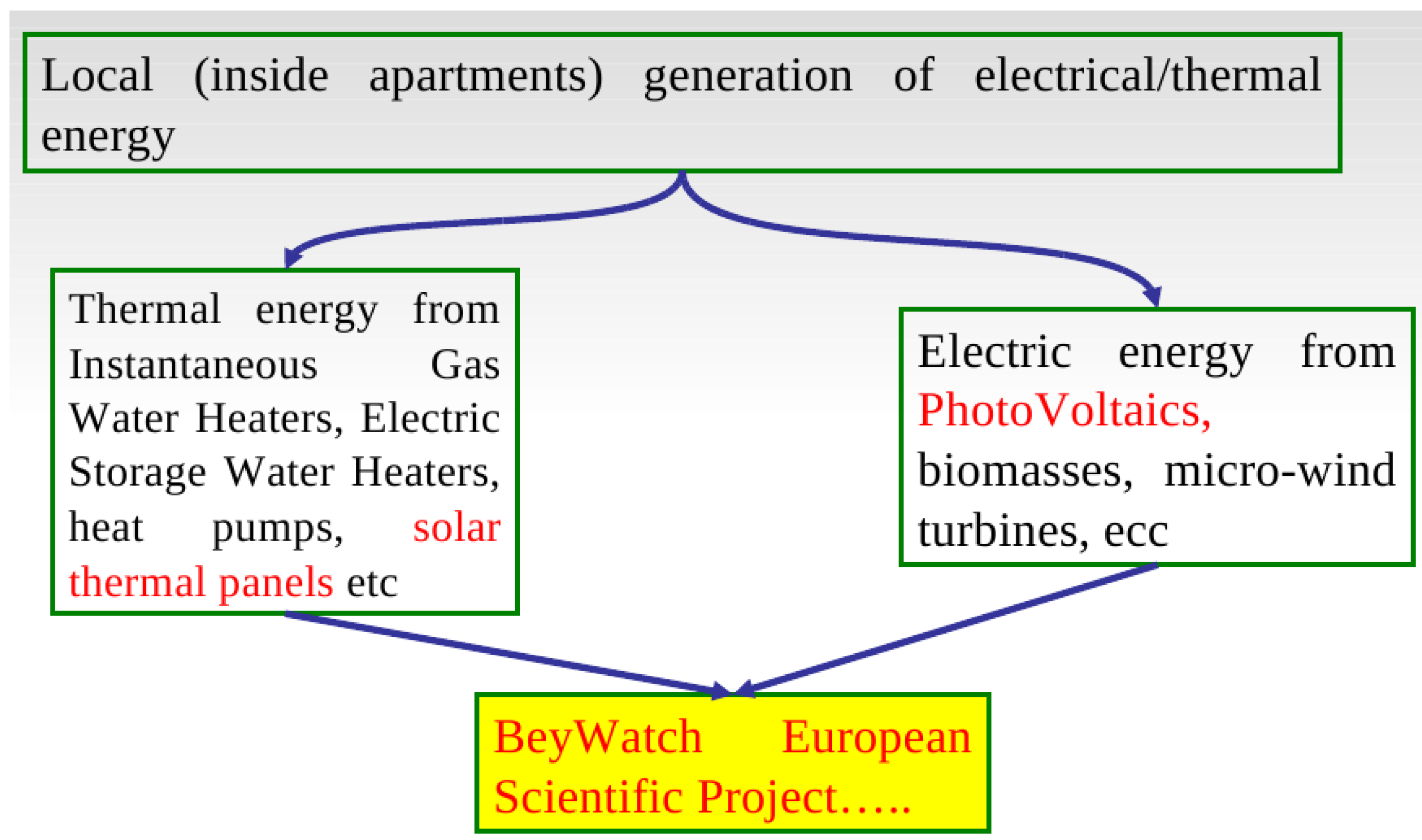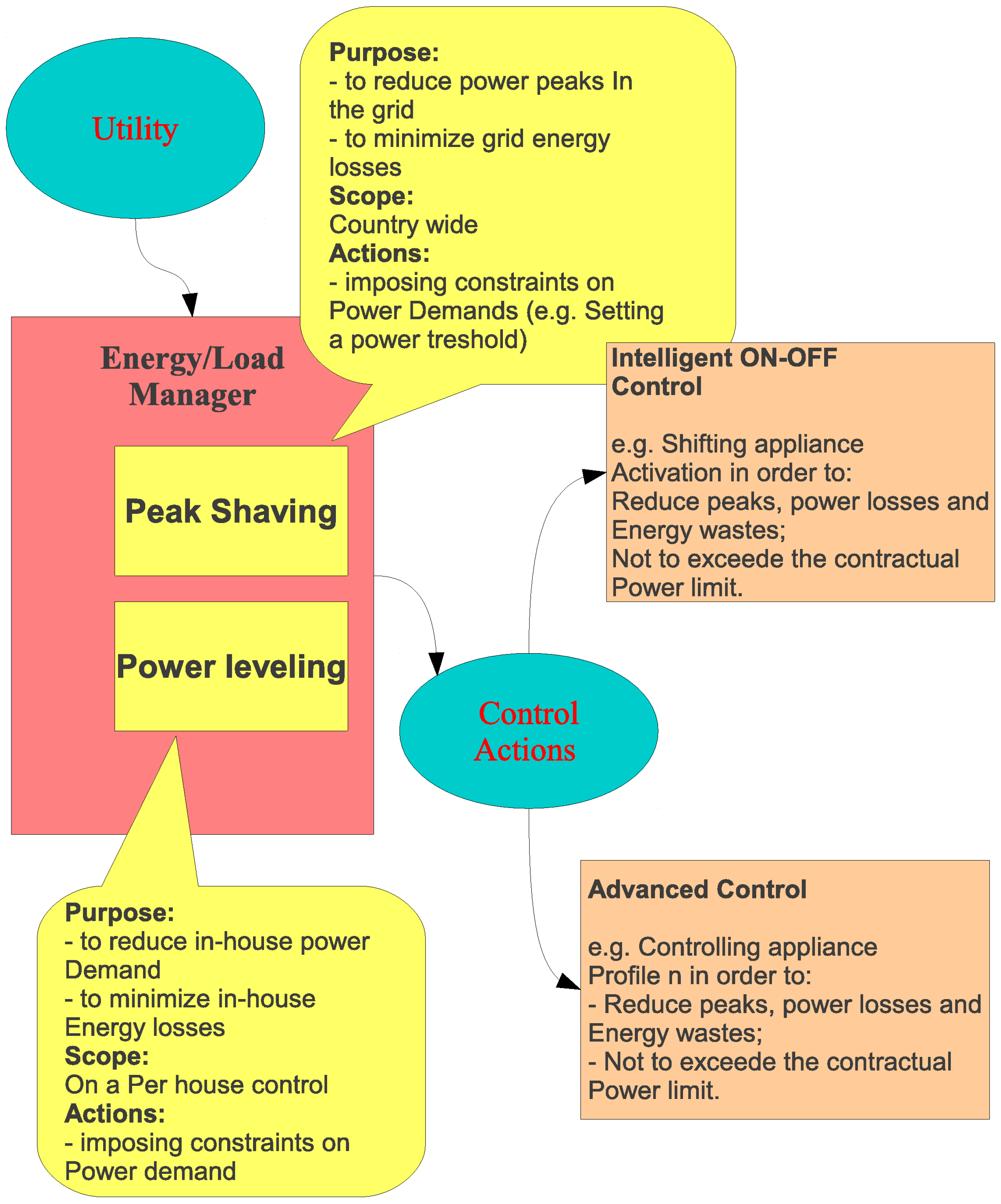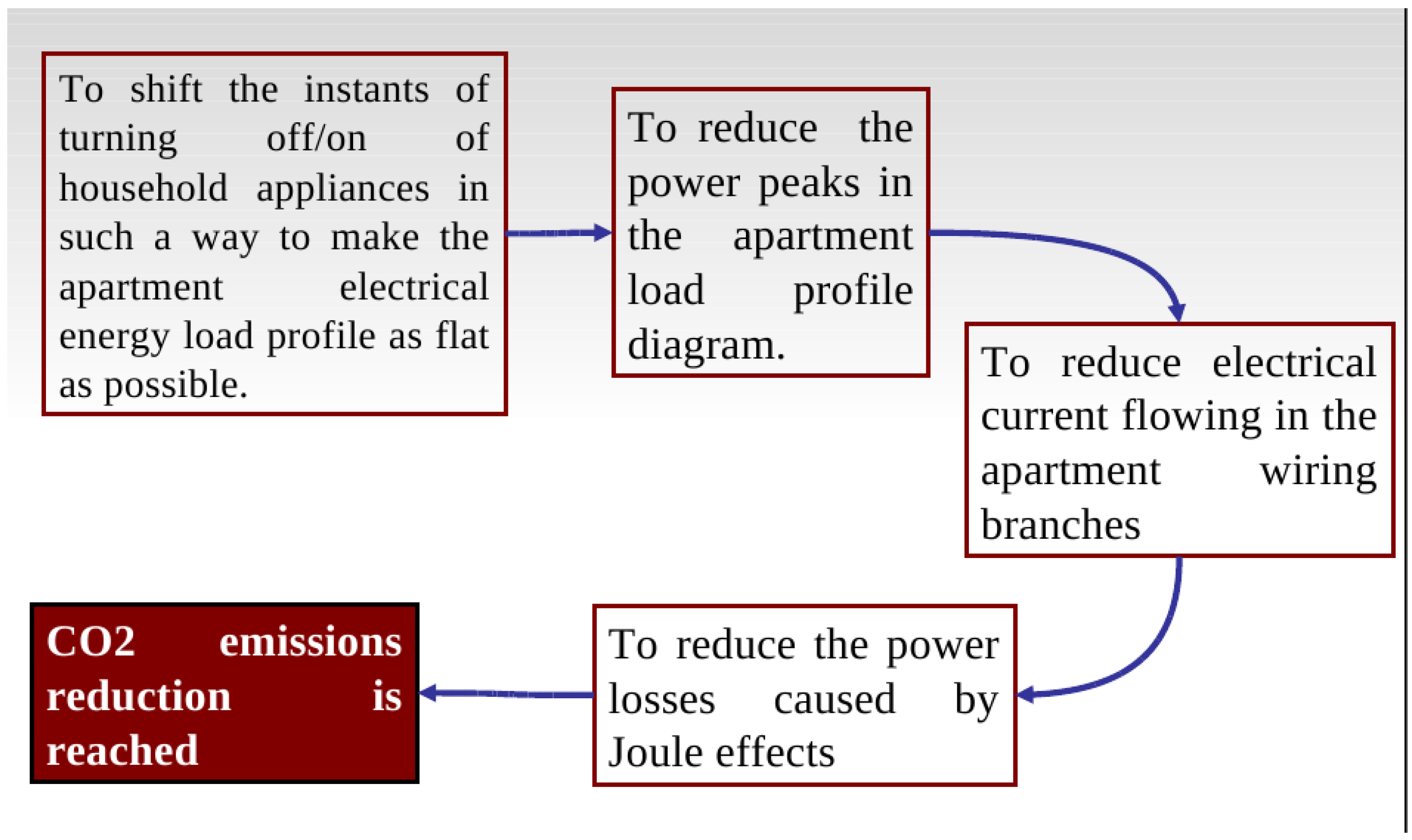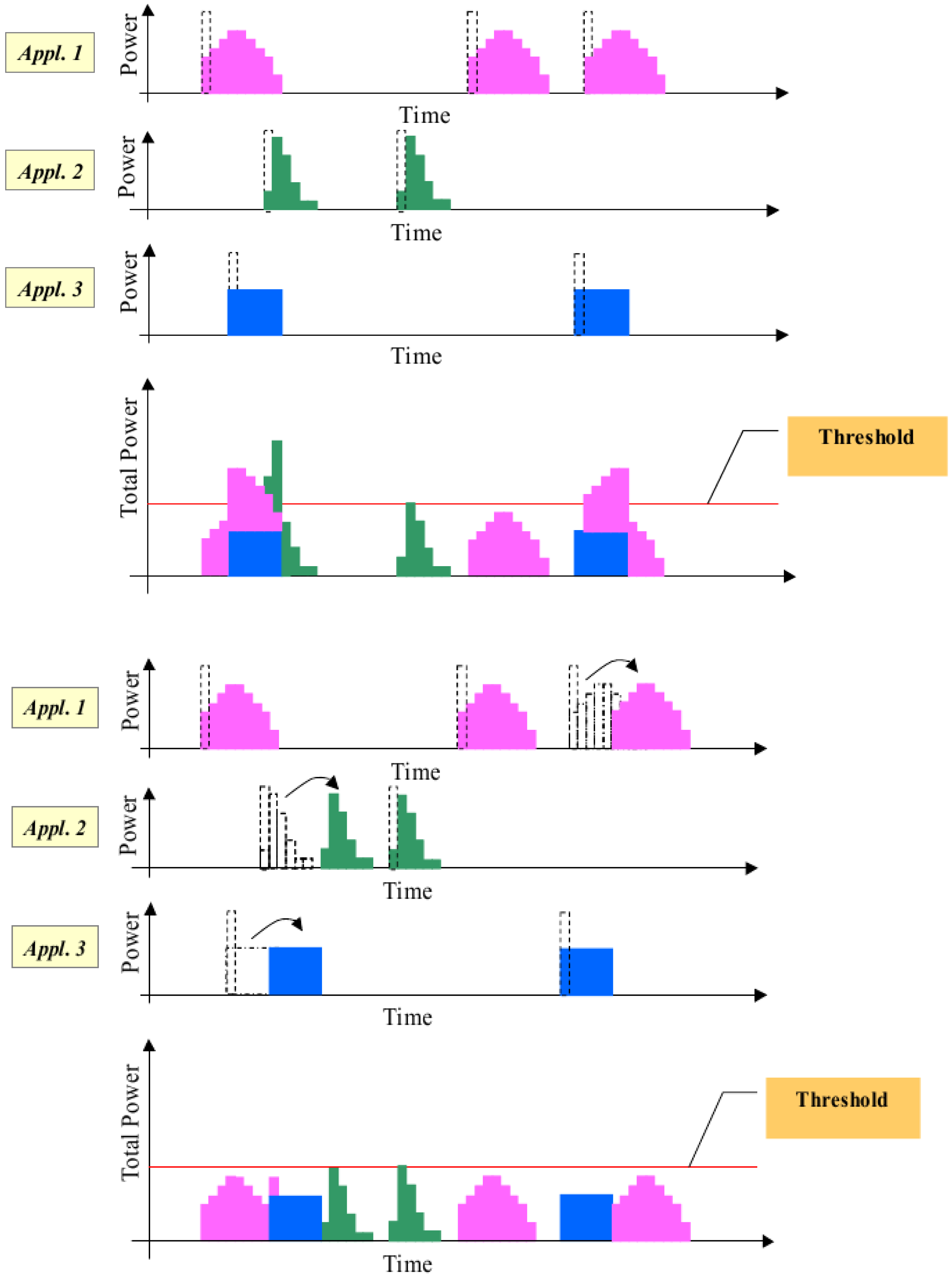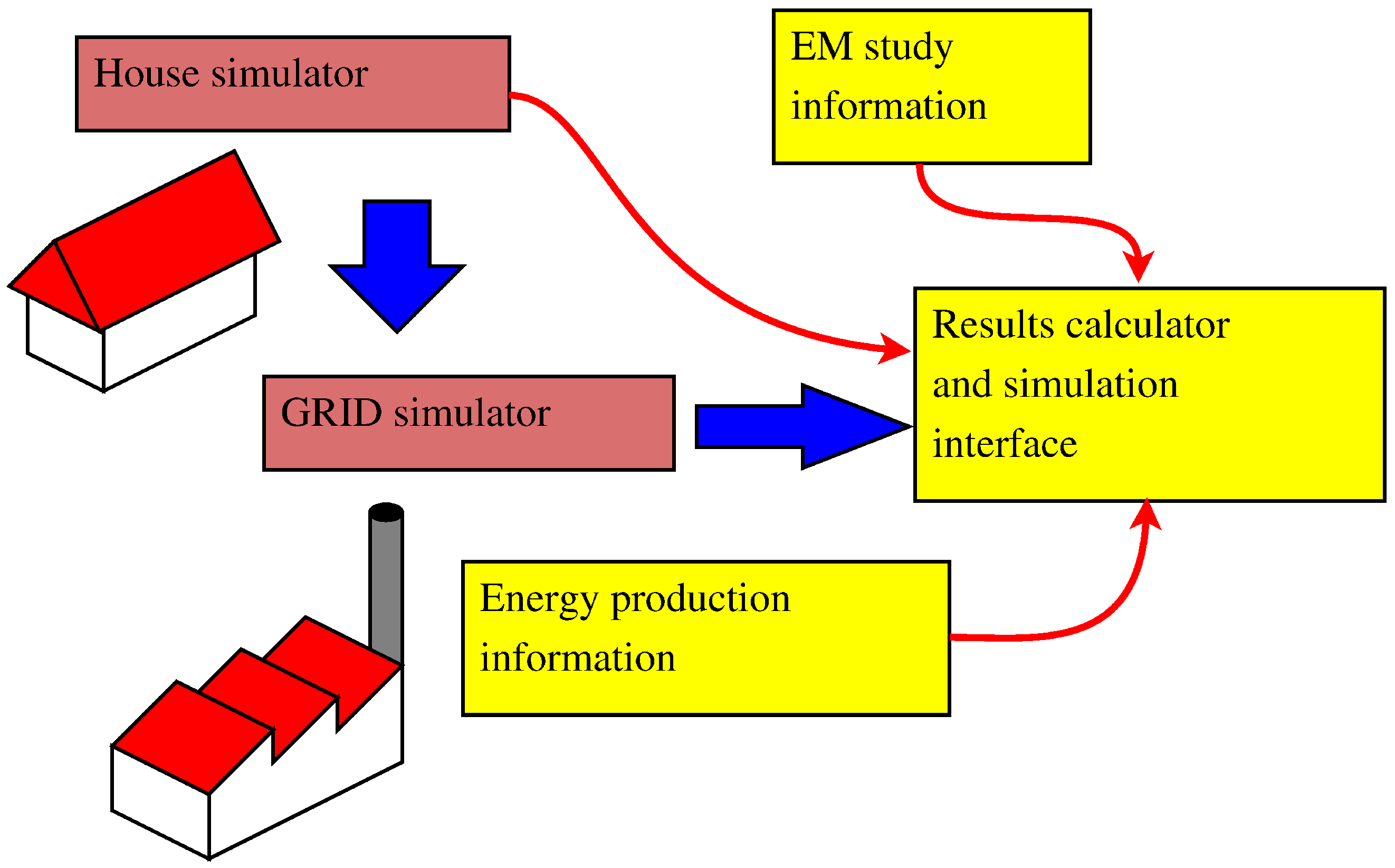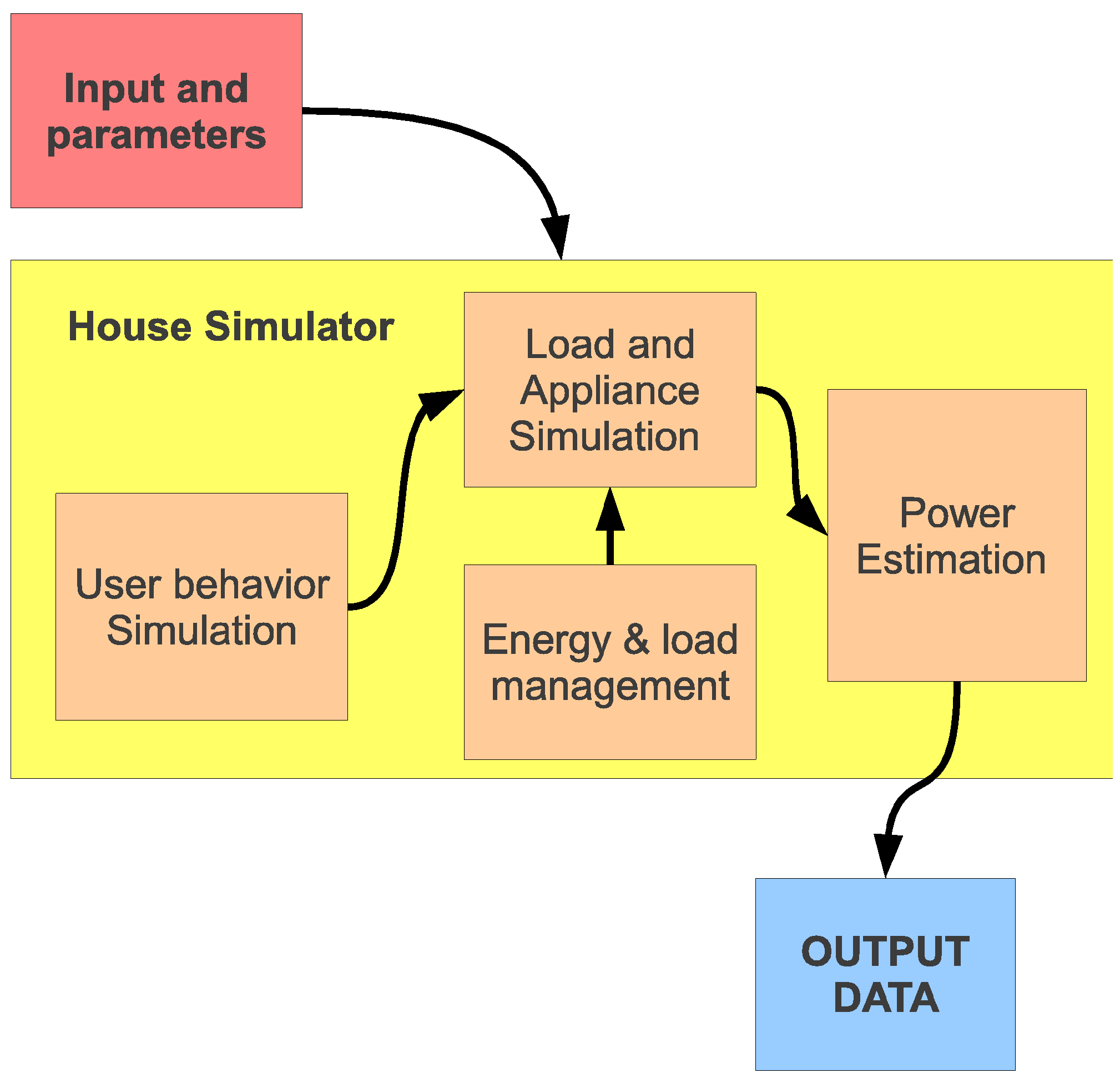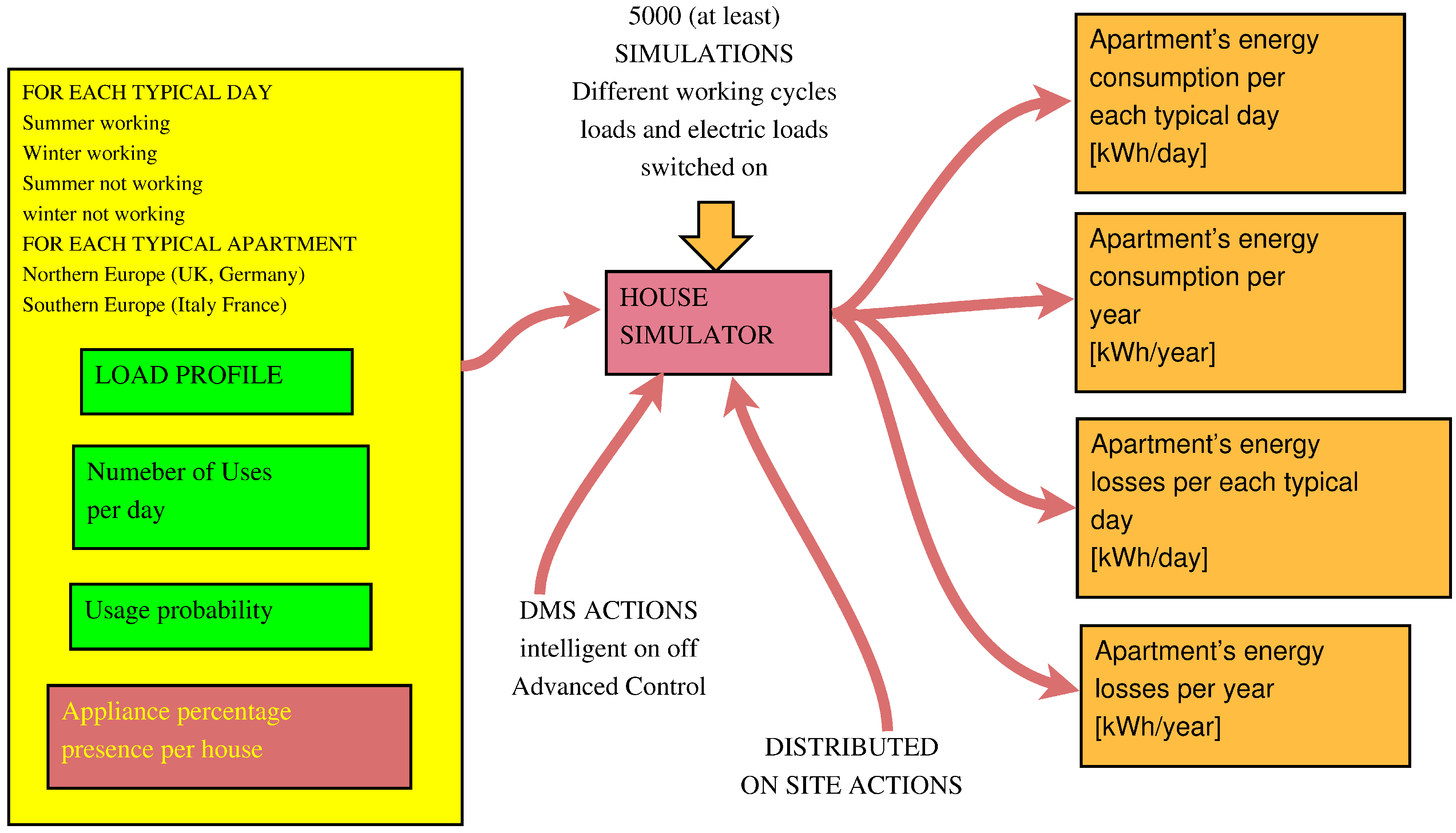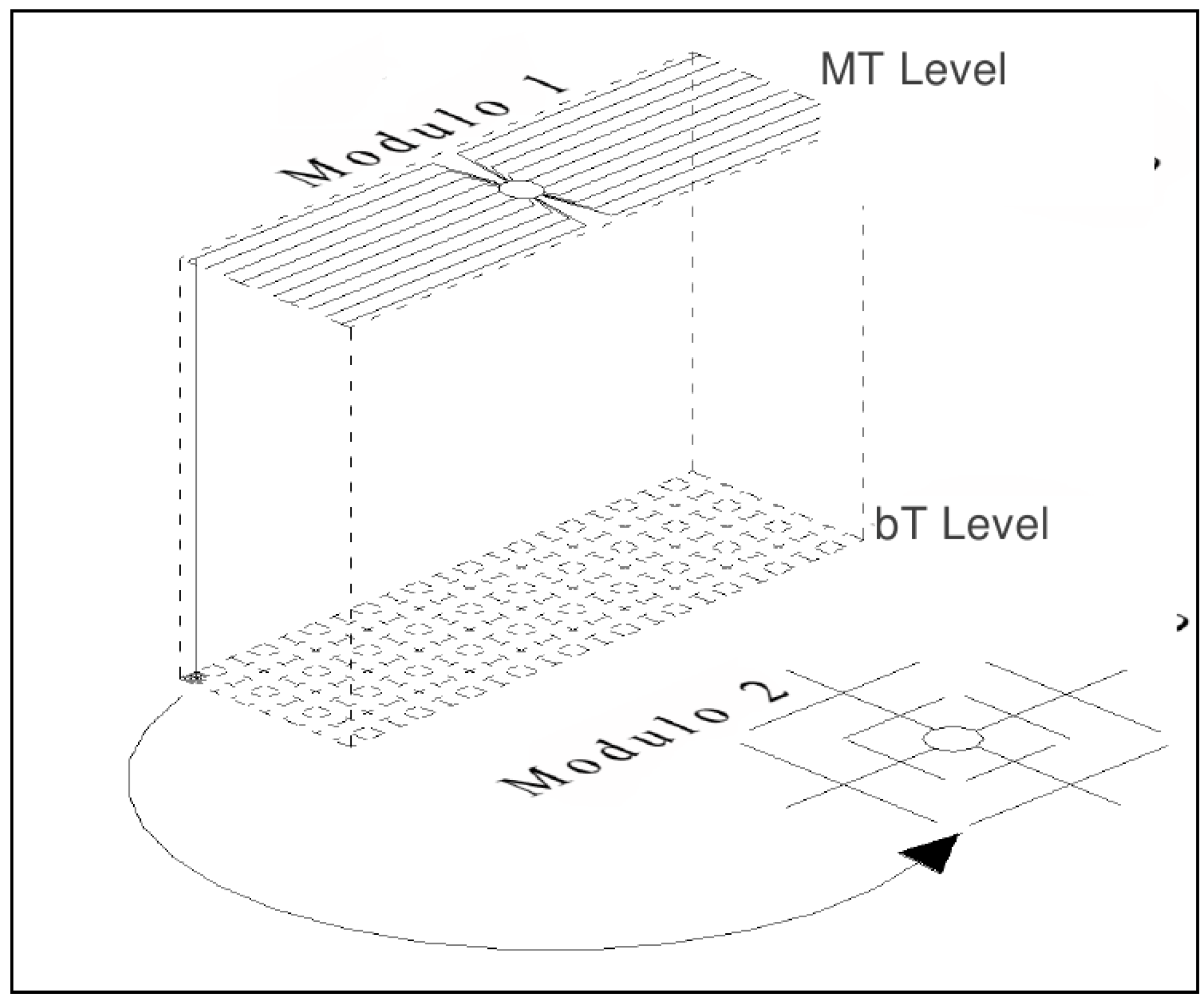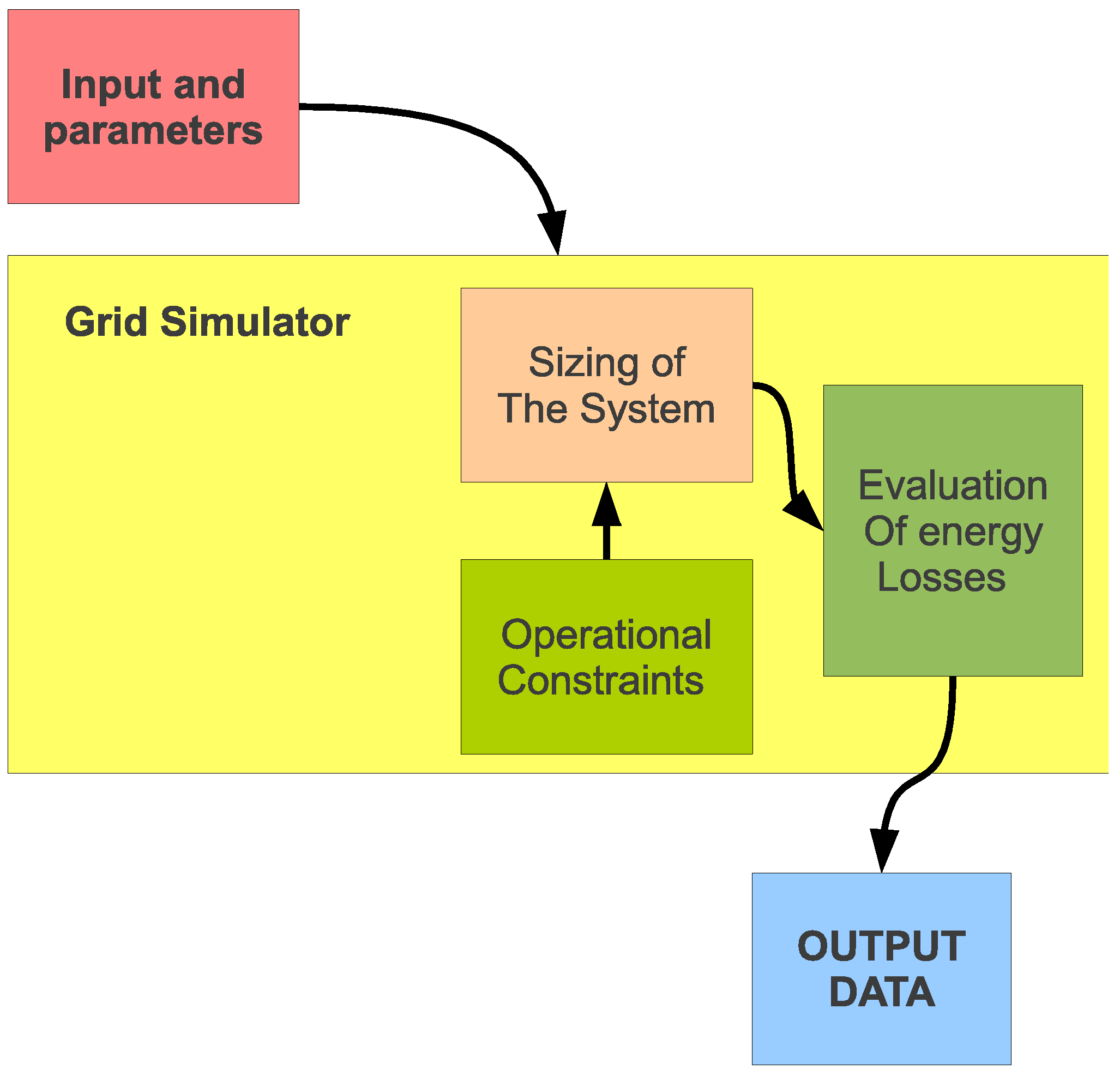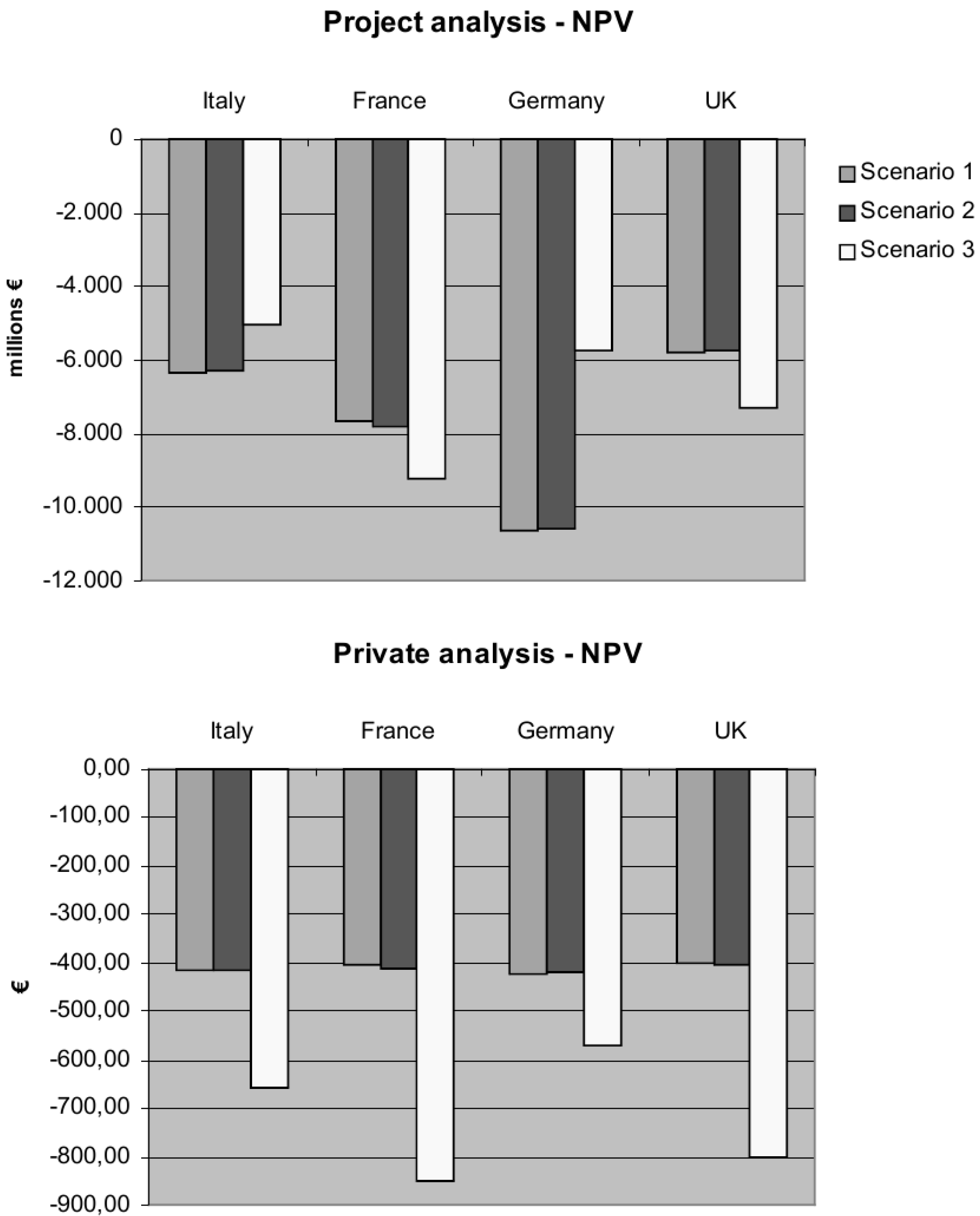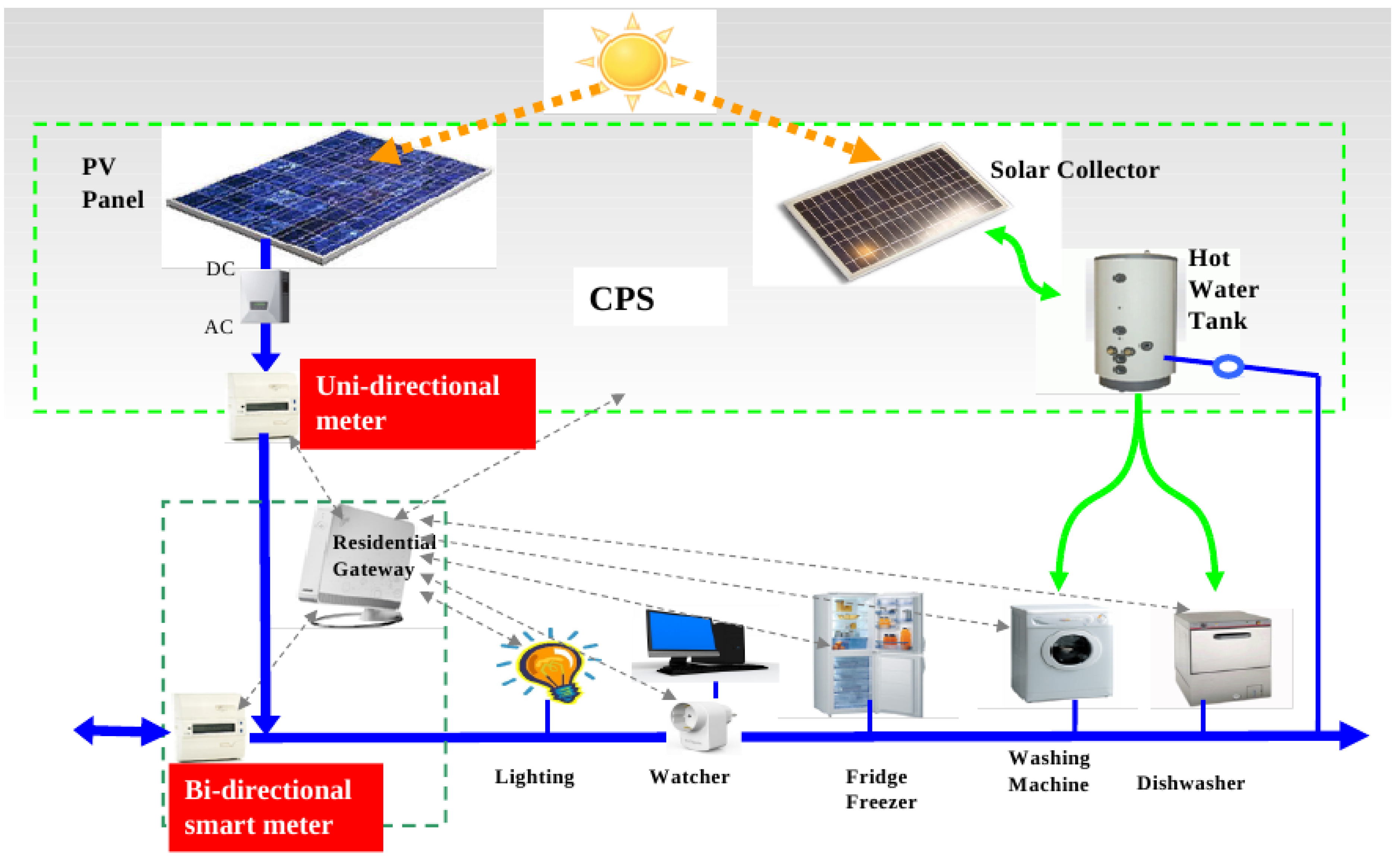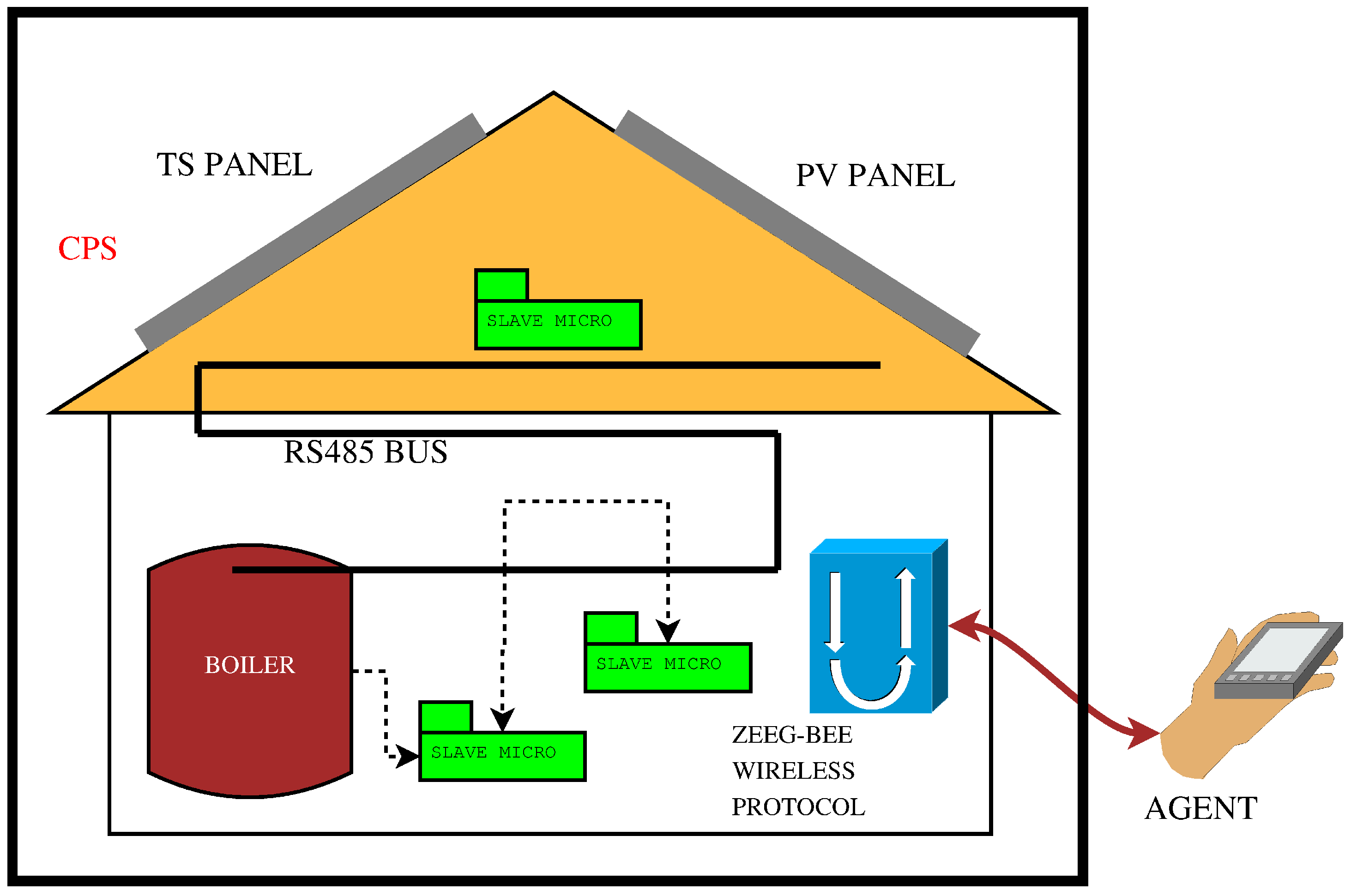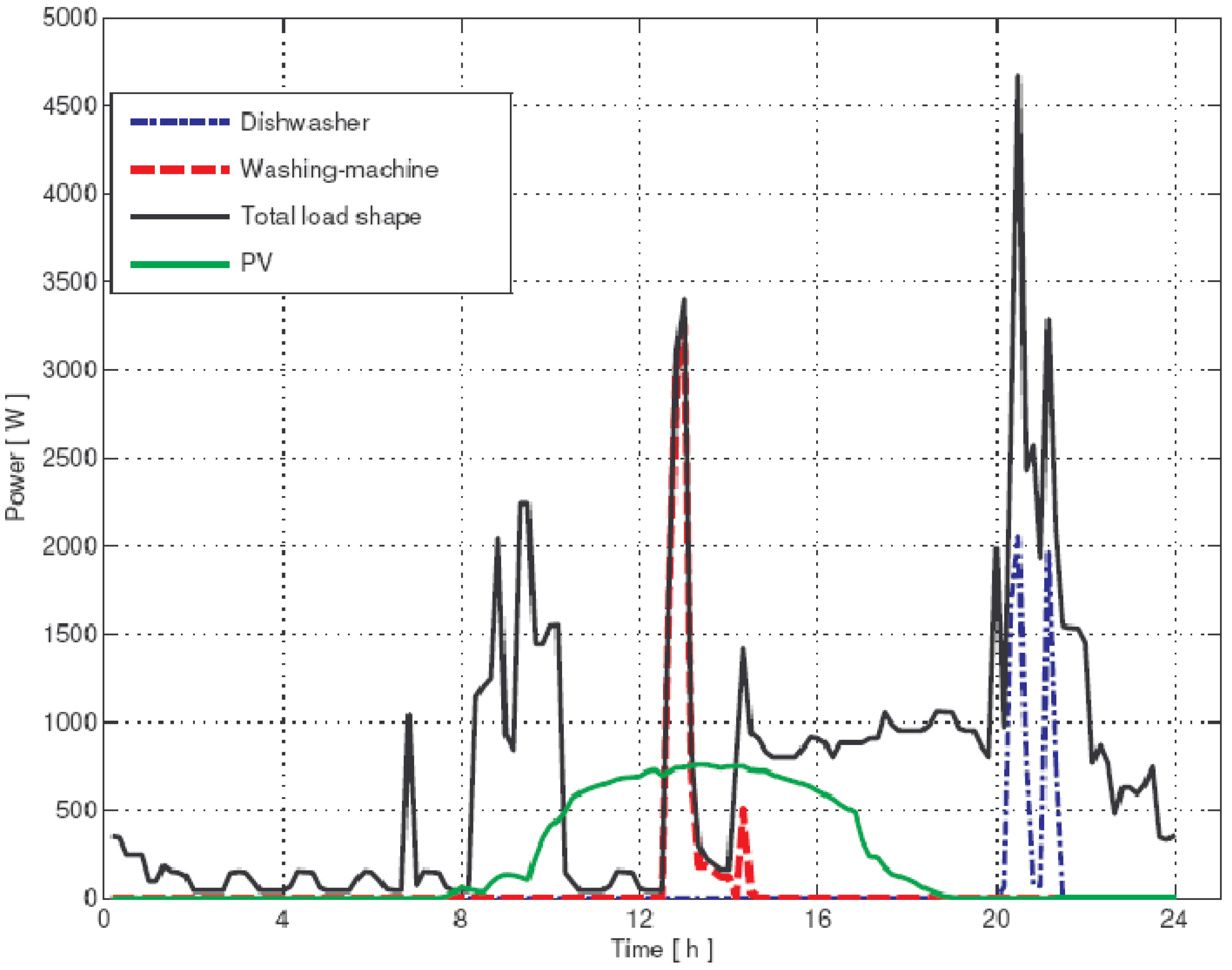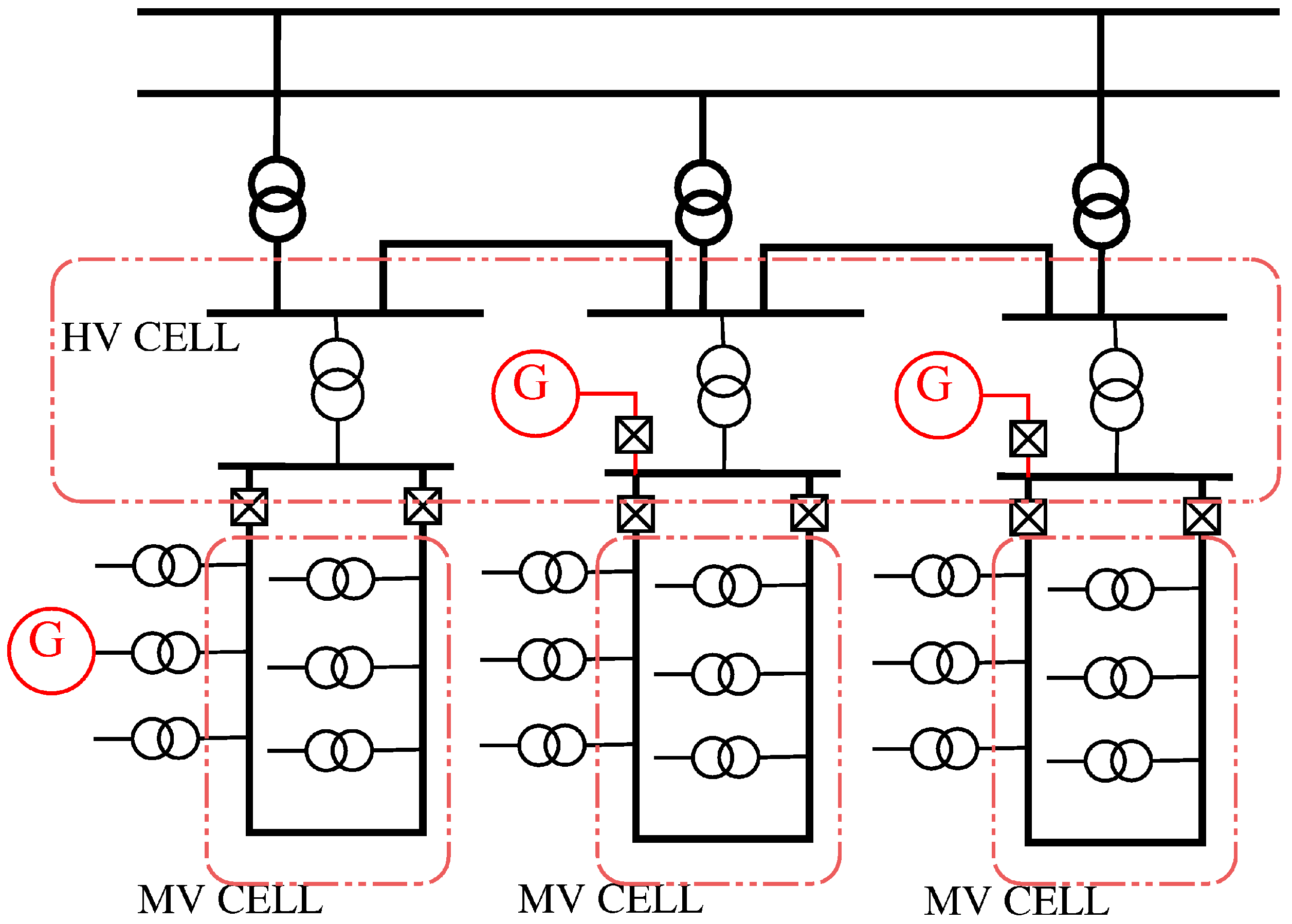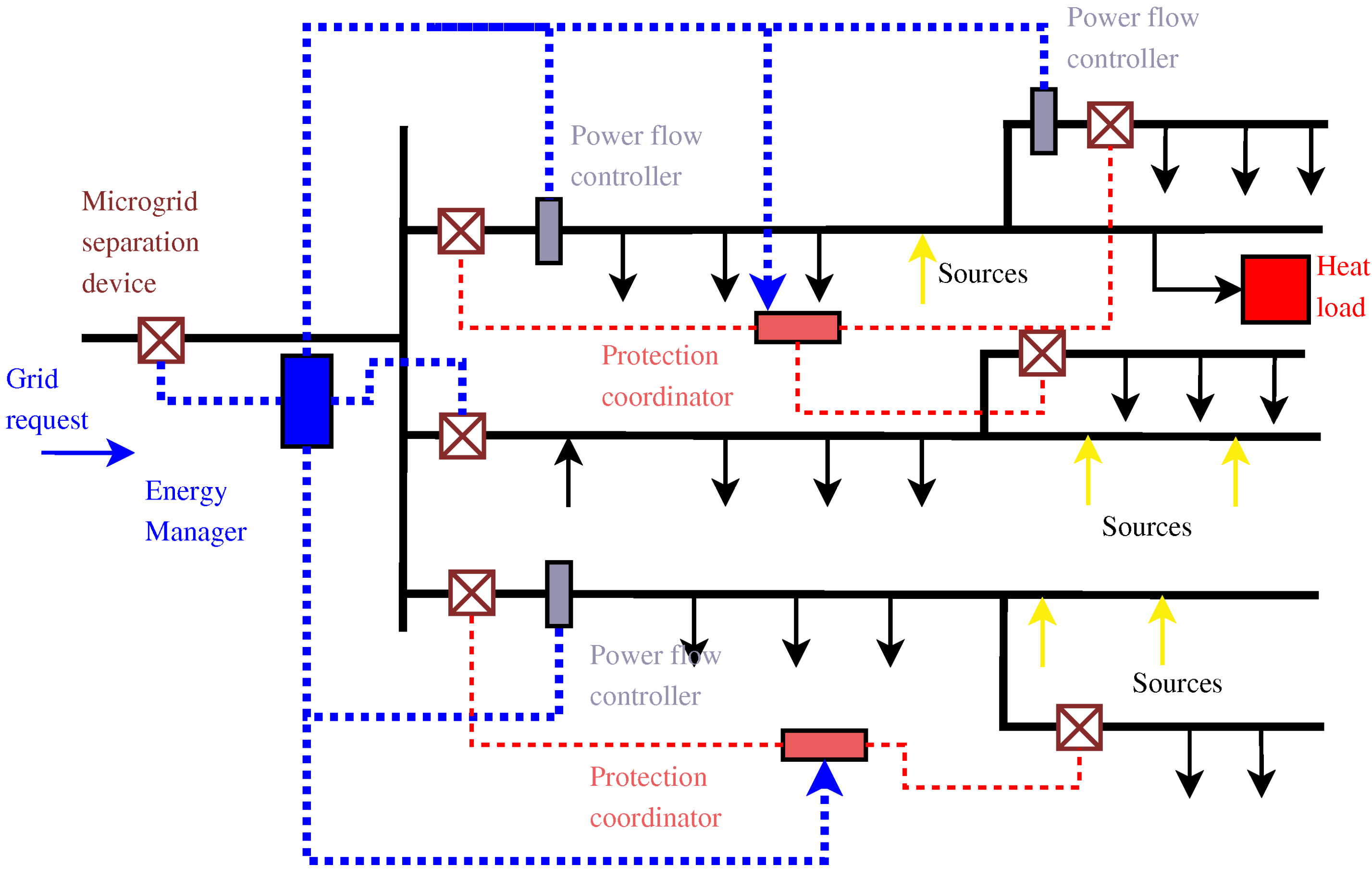1. Introduction
Efficient energy consumption is a key factor to Europe’s ambitious goals for sustainable development and activities related to air pollution and climate shifting. However, especially during the summer period, the complete electricity distribution network in Southern Europe is working under extremely high loads [
1].
Moreover, global climate scenarios show that the average temperature in EU Member States is likely to rise by 0.3–0.7 °C in the next 10 years and will continue to increase until at least the middle of the century. The probability of extreme temperatures will rise accordingly, and there will be corresponding demand from building users for the installation of cooling systems in homes and workplaces, further increasing energy consumption and surcharging the electricity distribution network [
1,
2,
3].
In order to tackle the increasing electricity demand, a number of solutions for efficient energy consumption, generation of energy from renewable sources and new power distribution business models for active energy control have been considered, and some of them have been even pushed via regulations at the national and European level. For example, in Spain, in August 2007, it was decided to replace all electricity meters in order to allow discrimination on the hourly rates of energy in such a way that users could tune their consumption pattern and contracts to the lower rates provided by the utility at given times of the day.
Targeting environmental sustainability, energy efficiency and new power distribution business models have to be evaluated. Moreover, innovative, energy-aware, flexible and user-centric solutions, able to provide interactive energy monitoring, intelligent control and power demand balancing at the home, block and neighbor level are needed. These solutions will interconnect legacy professional/consumer electronic devices with a new generation of energy-aware white-goods in a common network, where multilevel hierarchic metering, control and scheduling will be applied, based on power demand, network conditions and personal preferences. Moreover, renewable energy systems that will optimize and integrate, for example, an innovative combined photovoltaic/solar (CPS) system can be used. These systems will provide hot water for white goods (such as a dishwasher and washing machine) in order to strongly decrease the energy consumption and the CO emissions at home by reducing/removing the heating operational cycles; electrical energy from renewable energy sources (RES), which can be utilized at home and during peak periods, even fed to the electricity network in a reverse power generation/distribution business model.
Information from CPS system will be shared in the management network and used for a new set of energy management rules in order to maximize energy savings and environmental savings at the home, block and neighbor level.
In addiction to the energy management methodology to be used at the load level, they are now emerging in smart grids in the vision of power system innovation [
4].
The term "smart grid" is a term used to name an electrical energy delivering system merging both digital technologies and long transmission networks to optimize energy consumption, as well as to open up new processes for energy production and distribution.
The main driving factors to enhance current power distribution grids can be classified into different categories:
Improving reliability (by decreasing black-out or brown-out risks), efficiency and safety of the distribution grid through actions towards decreasing peak demand;
Increasing flexibility for power consumption;
Allowing homes to act either as electrical energy clients (when consuming) or as electrical energy suppliers (when producing); concerning the first driving factor, the total load connected to the grid can fluctuate considerably over time.
The overall load is not stable, and results from the sum of many individual working devices load profiles. For example, if a very popular TV program starts (e.g., the Football World Cup Final), millions of viewers will switch on their TV set nearly at the same moment, and it will result in a rapid increase of power consumption that could generate grid disruption and black-outs. This is the reason why mathematical algorithms have been created to predict power consumption increases, so that corrective actions can be taken.
Power outages and electricity blackouts and brownouts are very costly for energy providers and very uncomfortable for users.
Therefore, it is advantageous for both end-users, as well as for energy suppliers to decrease the number and the duration of high demand periods: grid maintenance costs, energy losses and the need for stand-by generators would be strongly reduced, and a better quality and reliable service would be offered to end-users.
Reliability, efficiency and safety improvements of power distribution networks are accomplished through communication and computing technologies. Smart grids can enhance the energy efficiency of the grid to the benefit of the end-users by both coordinating and scheduling low priority home devices, so that their power consumption takes advantage of the most appropriate energy prices and/or energy sources at a given time.
Furthermore, real-time information transmitted over communication networks will allow power outage anticipation, as well as service perturbation detection. By rapidly detecting and analyzing data coming from the distribution network, the smart grid will be in a position to take corrective actions, so as to restore power stability when needed. Harmonizing local distribution at the house level with energy distribution at a larger level can also reduce grid congestion.
Last, but not least, an enhanced electrical grid is expected to lower CO
emissions by reducing end-user energy consumption during peak hours, when electricity is generated through power plants that produce a lot of CO
emissions. Concerning the second driving factor, while minimizing operation and maintenance costs, a smart grid can also optimize capital assets: power production from a large number of small power providers using renewable energies (PV panels and small wind turbines) can be synchronized, leading to arrangements at local levels, and power production from centralized power plants can be optimized. End-users can benefit from the lowest-cost generation sources, as well as from centralized renewable energy sources (wind turbines). Harmonizing both ICT (information communication technology) with energy renewable sources can generate new ways for achieving energy savings and lowering CO
emissions [
5].
Finally, concerning the third driving factor of smart grid implementation aims at encouraging end-users to actively take part in grid operation by promoting incentive methods (real-time consumption information or real-time electricity pricing transported over communication networks) to make them behave as real actors of the entire electricity production and distribution system. Smart grid deployment also aims at changing end-user behavior by providing reliable services during high-demand periods.
Smart grids introduce and gather new actors, such as consumer devices, energy management devices, communication equipments and end-users to achieve a higher level of energy management. As a consequence, smart in-home appliances are connected with energy management devices (that are controlled by the end-users) over communication networks to better monitor energy consumption and production [
3,
6]. Real-time communication is a fundamental key point in smart grid development, because it allows end-users to get real-time electricity prices and incentive signals, giving them the choice either to consume energy or to sell it to the grid. This allows individual houses, as well as end-users to become real sources of energy production and to also provide effective means for energy savings.
Nowadays, research involving smart grids is widely spreading all over the world and will likely become a very attractive field of investigation, because of all the benefits that can be expected for both the end-users and the energy providers.
Smart grids can also be used to manage home appliance energy consumption. Such service relies on the fact that the frequency of the power grid gives reliable information on the grid congestion: when the grid frequency decreases (something, that usually happens at least once a day), it is likely that the grid is going to face a congestion problem.
By constantly monitoring the frequency of the power grid, individual electricity consuming devices (e.g., appliances) can shut off at relevant times in order to flatten and reduce spikes during peak periods. Because it is possible to measure frequency on the grid from any power sources (i.e., outlets), it is thus possible to incorporate in an appliance a piece of software performing as a real-time frequency meter that will supervise the appliance behavior (turn it on and off). The appliance would respond to the measured signal according to its value. When the grid frequency decreases (the grid faces a congestion problem), the smart appliance would switch off until the frequency will reach the expected threshold again (e.g., 50 Hz in Europe, 60 Hz in the United States of America). Similarly, when the grid frequency increases beyond its standard value, the smart appliance would switch on or would increase its power consumption, taking advantage of a low-power demand period.
Such a process has been experimented in the USA on fridges that shut off their compressor for two minutes in case of a grid frequency decrease, on the condition that the fridge contents are not harmed (the door is not opened during these two minutes, for instance). If at the end of this two-minute period the grid frequency is still under its normal value, the fridge will still stay off for another two-minute period, and so on, until a maximum of ten minutes have elapsed or until the frequency of the grid reaches its normal value again.
In the paper are reported the energy management analysis main goals and the house and grid simulators to determine the benefits, the cost benefit analysis and final results of energy management. In addition, an example of an energy management system is presented. Finally, problems related to smart grids as the next future of electrical distribution systems are presented and discussed.
2. Energy Management Analysis
Energy efficiency is a major concern for sustainable development activities, because increasing energy consumption implies usually increasing CO emissions and a long lasting impact on global warming. The energy demand has been constantly growing over the last few years, partly because of the emergence of new electrical applications, such as new services and new technologies for transportation, requiring increasing investments in the energy producing sector.
Furthermore, during some specific periods, the electricity distribution network can be under stress, because of high power demand. In order to face the rising electricity demand, a number of solutions for efficient energy consumption can be found. Indeed, energy management entails all the actions that could influence the demand for energy, such as actions to suppress ineffective energy consumption and actions to dim energy consumption at a large or medium scale. Energy generation from renewable sources and new power distribution business models for active energy control have been promoted and sometimes have been even legitimized via regulations at the national and European level. Besides, it is often mentioned that energy efficiency and renewable energy are the so-called “twin pillar” of sustainable development. These are fundamental to slow the increasing demand of energy [
7].
In this meaning, the energy management analysis main goals are:
To understand the environmental benefits of energy management through connected household appliances with clear figures—the analysis should take stand-by consumption into account, as well as the fact that it avoids demand peaks, reduces energy losses;
To quantify the reduction in CO emission enabled by a better consumption and load management;
To perform a cost benefit analysis of a house energy management system.
The energy management analysis work approach is presented in
Figure 1 in which it is easy to understand that all of the electricity value chain has to be considered.
Figure 1.
Energy management analysis work approach.
Figure 1.
Energy management analysis work approach.
Moreover, it is to be considered that common human activities, carried out each day in individual houses, are characterized by quite regular patterns. These patterns significantly affect the usage of electricity, either considering a single house or a number of houses connected to the same power grid.
The mentioned patterns and their synchronism make the instantaneous energy demand strongly variable over the day, negatively affecting the overall efficiency of the entire energy supply chain (from an energetic, economic and environmental point of view). This is mainly due to the presence of peak demands, i.e., the synchronous request for energy from multiple house. Peak demands imply a greater current to flow on the power grid and on the house wiring systems, that raises energy waste, due to power losses (e.g., caused by Joule effects). Moreover, energy demand is usually concentrated in the daytime, while it is small during night hours. This is in contrast with the desired flat energy profile provided by power plants. A flat energy demand is needed to achieve a better efficiency in exploitation of primary energy sources.
Distributed Side Management (DSM) and Distributed on Site (DoS) control actions are implemented with the aim of reducing peaks in energy demand and to make the energy demand pattern flatter, either at a per-house and at a grid level. This is mainly obtained by avoiding the synchronous activation of appliances or loads and by optimizing their activation in order to achieve the overall better energy efficiency and by doing this in the most transparent way with respect to the end-users. Distributed on Site (DoS) actions (see
Figure 2) are complementary to DSM actions and allow one to achieve even better performances by exploiting some form of local energy generation, such as combined heat and power (CHP) systems, solar panels for water heating, photovoltaic panels, and so on. In order to be deployed, these strategies have to be supported by specific appliances or house infrastructures, by suitable control algorithms executed by a centralized device, called “Load/Energy Manager”, that is able to manage communication with the appliances and also with the power grid.
Figure 2.
Distributed on site action.
Figure 2.
Distributed on site action.
Residential energy users are interested in having a cheaper energy cost and may be interested in increasing “social” savings in terms of CO
emissions reduction and global warming. Both can be achieved by adopting DSM strategies. The Demand Side Management control actions here proposed are realized on the per-house load. These actions perform two objectives:
Peak shaving, applied on a country-wide level: the utility manages the power consumptions of entire groups of houses (communicating with their residential gateway) with the aim of reducing energy losses in transmission and distribution power systems and avoiding troubles related to power quality and energy production. The utility sends a command to the energy/load manager, which will perform the peak shaving function;
Power leveling, applied on a per-house level: an energy/load manager in each house takes care of leveling power consumptions below a certain threshold with the aim of minimizing in-house power losses, shifting activation of appliances in periods with cheaper energy costs and maintaining the instantaneous house load under the contractual maximum. The proposed power leveling control actions perform both the load management (direct DSM) and the energy cost management (indirect DSM) functions.
The Demand Side Management is gaining, today, more and more attention from technicians and investors. The
Figure 3 shows the recent investment amount by the main energy companies in the USA in millions of US dollars.
Figure 3.
Investments on Demand Side Management (DSM) in the USA.
Figure 3.
Investments on Demand Side Management (DSM) in the USA.
Each of the these objectives can be fulfilled by using two control strategies [
8]:
These considerations and the resulting scenario are summarized in
Figure 4. It is important to have a global overview of energy management actions inside apartments. In
Figure 5, this overview is reported, while in
Table 1, the load shifting actions (see also
Figure 6) are explained in detail.
Figure 4.
DSM function block diagram.
Figure 4.
DSM function block diagram.
Figure 5.
Global overview.
Figure 5.
Global overview.
Table 1.
Load shifting.
| Appliance type | Activation priority | De-activation priority | Delay time |
|---|
| Washing Machine | | | 30’ |
| Dish Washer | | | 30’ |
| Dryer | | | - |
| Electric storage water heater | | | 30’ |
| Oven | | | 30’ |
| Hob | | | - |
| Fridge/Freezer | | | 30’ |
| Air Conditioner | | | 30’ |
Figure 6.
Load shifting action road map.
Figure 6.
Load shifting action road map.
For DoS, control action is the intended action of generating electric or thermal energy in the place where it will be absorbed by the final user in order to obtain a better performance of the generating-consuming system; see
Figure 7.
DoS control actions include:
Type 1: production of electric energy from photo-voltaic (PV) systems, biomass, micro-wind turbines, etc.;
Type 2: production of thermal energy from an instantaneous gas water heater (IGWH), electric storage water heater (ESWH), heat pump, solar panels, etc.;
Type 3: production of both electric and thermal energy through CHP (combined heat and power) and CHCP (combined heat and cool and power) systems.
The choice of one of these systems significantly affects the daily power profile and the power peak of a given electric installation.
Figure 7.
Power leveling.
Figure 7.
Power leveling.
The purpose of this analysis is to quantify the effects, in terms of savings or wastes of energy, of the production with generating systems based on renewable technologies and of sanitary domestic hot water (SDHW) for feeding not only the normal domestic users (basin, kitchen sink, shower and bath), but also the dishwasher (DW) and the washing machine (WM) if present in the house. Indeed, this kind of action allows one to eliminate, from the power profile of these two appliances, the part due to the water pre-heating phase, with effects of peak shaving and power leveling on the house daily power profile. On the other side, the generating system requires electric or primary energy for producing the required hot water, and this has an opposite effect on the house daily power profile.
The aim of this analysis is to investigate if these contrasting effects can lead to energy savings for the final user or to a reduction of CO
emissions for the whole electric system. To evaluate energy management results, the simulation of the system has been implemented, and the study reported hereafter provides results based on a campaign of simulations conducted on software simulators, as described in the chart of
Figure 8.
Figure 8.
Energy management study chart.
Figure 8.
Energy management study chart.
Energy savings have been considered both at the house level and at the grid level in four European countries: Italy, France, Germany and the United Kingdom. Four scenarios have been considered, those being:
Scenario 0: typical house;
Scenario 1: house with intelligent on/off;
Scenario 2: house with intelligent on/off plus advanced actions;
Scenario 3: house with intelligent on/off plus advanced actions plus water heating outside the appliance.
The present study has been made by considering that the energy production along the time horizon of 13 years has the same mix today as present in Europe. This is a kind of starting point, but a more precise analysis should take into account trends of electric energy production [
8]. With respect to this, a dynamic model should be implemented for the evaluation of the savings on primary production, on CO
emissions and on local impacts [
9].
In order to evaluate instantaneous domestic power consumptions and losses, a house simulator has been developed. The simulator is able to deliver accurate numerical data considering a number of different scenarios, e.g., considering houses using traditional appliances, houses with intelligent appliances and a house capable of implementing DoS functionalities. In order to obtain more realistic results, a Montecarlo method was used. This approach is necessary, since different houses (or even the same house in different days) exhibit different usage patterns of appliances and loads. Therefore, in order to calculate in a more realistic way power peaks and losses (one of the key factors in this study) arising from the simultaneous activation of appliances, it is necessary to execute a huge number of simulations using stochastic inputs. These inputs (e.g., usage patterns or numbers of activation per day) can be statistically characterized by means of statistical data or surveys in order to closely reproduce user behavior and customs [
8].
The simulator is able to evaluate, for each 10 min interval in a day, which are the active appliances and loads, their instantaneous power and energy consumptions and the in-house power losses. In order to obtain a satisfactory statistical coverage, a big number of runs (on the order of 5000) have been executed; then, the most frequent values have been gathered. A typical apartment (surface =
; wiring layout: radial with a main feeder starting from the home’s electricity meter and arriving to the main switchboard). From the switchboard, a series of lines and sub-lines supply the electrical defined loads. People living in a family made of four persons (parents and children)) (see
Figure 9), four typical days, number of uses per day and usage pattern have been taken into account.
Figure 9.
Typical apartment.
Figure 9.
Typical apartment.
Four typical days have been considered:
The use of each electric load depends on non-deterministic factors, such as:
Only through a probabilistic approach is it possible to take into account all the above-mentioned factors. In order to have the most probable load profile of a given typical house, it has been necessary to execute a big number of simulations (“the great number law”).
The house simulator is composed of four different functional units:
“User behavior simulation”, for the stochastic generation of usage patterns;
“Load and appliance simulation”;
“Power estimation”, for the evaluation of the power consumption and energy losses;
“Energy and load management”, for the implementation of Demand Side Management and/or Distributed on Site control actions.
The simulator structure is showed in
Figure 10. It takes as input the data of the apartment wiring layout, appliances and their load profiles, statistic appliance usage patterns and presence factors.
In
Figure 11, the input and data output of the house simulator are reported.
In order to extract simulation results, the basic simulation routine, which covers a single house and a single day, is iterated from 1000 to 5000 times (until the results converge within the 0.5% of the final value) in order to obtain data for a number of different houses for the same country and a typical day. These data, containing information, such as the peak power consumption and power losses, are automatically analyzed, so to extract the distribution and the most frequent data, as well as some derived figures that are used by the grid simulator.
Table 2,
Table 3,
Table 4 and
Table 5 provide house simulator results for the four countries under investigation. Reduction of water heating, either by ESWH and appliances, allows one to significantly reduce the house energy consumption, power peaks and power losses. This scenario guarantees the greatest saving in terms of energy, money and CO
emissions. This high reduction in energy consumption and power peaks gives further savings when considering the entire grid and production system.
Figure 10.
House simulator structure.
Figure 10.
House simulator structure.
Figure 11.
Input and data output.
Figure 11.
Input and data output.
Table 2.
House energy losses per country-reference scenario.
Table 2.
House energy losses per country-reference scenario.
| Country | Day type | Energy consumption (kWh/Day) | Peak power (kW) | Energy losses (Wh) | Number of typical days | Energy losses/year (Wh) |
|---|
| Italy | winter non-working | 10.991 | 3.278 | 118.016 | 78 | 50,080.87 |
| winter working | 10.686 | 3.201 | 114.114 | 194 |
| summer non-working | 13.518 | 3.503 | 178.953 | 26 |
| summer working | 15.073 | 3.619 | 210.218 | 67 |
| France | winter non-working | 12.124 | 3.363 | 167.941 | 78 | 71,825.27 |
| winter working | 12.973 | 3.334 | 189.101 | 194 |
| summer non-working | 14.581 | 3.680 | 230.252 | 26 |
| summer working | 15.129 | 3.644 | 239.603 | 67 |
| Germany | winter non-working | 12.660 | 3.613 | 169.944 | 78 | 63,748.96 |
| winter working | 12.766 | 3.594 | 176.201 | 194 |
| summer non-working | 12.521 | 3.492 | 170.173 | 26 |
| summer working | 12.757 | 3.624 | 177.397 | 67 |
| UK | winter non-working | 13.017 | 3.643 | 201.441 | 78 | 81,778.93 |
| winter working | 14.177 | 3.719 | 230.433 | 194 |
| summer non-working | 14.075 | 3.742 | 232.295 | 26 |
| summer working | 14.190 | 3.622 | 228.698 | 67 |
Table 3.
House energy losses per country-scenario 1.
Table 3.
House energy losses per country-scenario 1.
| Country | Day type | Energy consumption (kWh/Day) | Peak power (kW) | Energy losses (Wh) | Number of typical days | Energy losses/year (Wh) |
|---|
| Italy | winter non-working | 11.198 | 2.949 | 116.580 | 76 | 47,782.57 |
| winter working | 10.484 | 2.969 | 107.787 | 194 |
| summer non-working | 13.311 | 2.958 | 169.761 | 26 |
| summer working | 14.922 | 3.018 | 199.474 | 67 |
| France | winter non-working | 11.865 | 3.180 | 161.364 | 76 | 66,166.81 |
| winter working | 12.194 | 3.170 | 169.312 | 194 |
| summer non-working | 14.342 | 3.311 | 217.483 | 26 |
| summer working | 14.839 | 3.353 | 225.107 | 67 |
| Germany | winter non-working | 12.637 | 3.338 | 164.021 | 76 | 61,585.36 |
| winter working | 12.746 | 3.336 | 170.433 | 194 |
| summer non-working | 12.499 | 3.261 | 164.383 | 26 |
| summer working | 12.726 | 3.348 | 170.948 | 67 |
| UK | winter non-working | 13.302 | 3.550 | 200.478 | 76 | 78,938.94 |
| winter working | 13.984 | 3.571 | 222.817 | 194 |
| summer non-working | 13.575 | 3.527 | 216.129 | 26 |
| summer working | 13.798 | 3.525 | 215.756 | 67 |
Table 4.
House energy losses per country-scenario 2.
Table 4.
House energy losses per country-scenario 2.
| Country | Day type | Energy consumption (kWh/Day) | Peak power (kW) | Energy losses (Wh) | Number of typical days | Energy losses/year (Wh) |
|---|
| Italy | winter non-working | 10.847 | 3.131 | 115.062 | 76 | 48,231.74 |
| winter working | 10.604 | 3.127 | 109.082 | 194 |
| summer non-working | 13.311 | 3.107 | 169.627 | 26 |
| summer working | 15.109 | 3.284 | 204.253 | 67 |
| France | winter non-working | 11.971 | 3.323 | 161.598 | 76 | 71,689.49 |
| winter working | 12.730 | 3.312 | 286.749 | 194 |
| summer non-working | 14.557 | 3.469 | 227.208 | 26 |
| summer working | 15.964 | 3.605 | 252.955 | 67 |
| Germany | winter non-working | 12.649 | 3.396 | 167.612 | 76 | 60,574.94 |
| winter working | 12.570 | 3.373 | 165.531 | 194 |
| summer non-working | 12.388 | 3.330 | 163.629 | 26 |
| summer working | 12.644 | 3.365 | 166.174 | 67 |
| UK | winter non-working | 13.735 | 3.503 | 211.508 | 76 | 80,499.82 |
| winter working | 13.822 | 3.618 | 221.341 | 194 |
| summer non-working | 13.860 | 3.570 | 223.264 | 26 |
| summer working | 14.389 | 3.651 | 227.724 | 67 |
Table 5.
House energy losses per country-scenario 3.
Table 5.
House energy losses per country-scenario 3.
| Country | Day type | Energy consumption (kWh/Day) | Peak power (kW) | Energy losses (Wh) | Number of typical days | Energy losses/year (Wh) |
|---|
| Italy | winter non-working | 8.458 | 2.494 | 69.703 | 76 | 32,423.39 |
| winter working | 8.244 | 2.459 | 67.154 | 194 |
| summer non-working | 10.992 | 2.541 | 128.308 | 26 |
| summer working | 12.625 | 2.658 | 158.544 | 67 |
| France | winter non-working | 11.470 | 3.124 | 154.149 | 76 | 66,424.98 |
| winter working | 12.270 | 3.055 | 172.064 | 194 |
| summer non-working | 13.641 | 3.257 | 206.595 | 26 |
| summer working | 15.016 | 3.404 | 233.571 | 67 |
| Germany | winter non-working | 11.146 | 3.065 | 130.051 | 76 | 48,121.17 |
| winter working | 11.106 | 3.069 | 131.881 | 194 |
| summer non-working | 11.094 | 3.001 | 129.437 | 26 |
| summer working | 11.270 | 3.112 | 134.726 | 67 |
| UK | winter non-working | 12.859 | 3.500 | 196.390 | 76 | 76,062.92 |
| winter working | 13.632 | 3.517 | 214.635 | 194 |
| summer non-working | 12.976 | 3.415 | 205.294 | 26 |
| summer working | 13.255 | 3.332 | 205.486 | 67 |
It has to be noted, however, that since in this case there are less heavy electrical loads to shift in the house, the DSM actions are relatively ineffective [
10].
These results are useful to be inputs for the grid simulator that is needed to evaluate the energy management actions on the entire electric value chain and, so, on the grid, too.
The use of Demand Side Management methodologies, in fact, can slow down the growth rate of the yearly peak load and energy demand; the aim of the analysis is to evaluate the advantages deriving from the application of a set of load-control end-user policies.
The analysis has been performed by considering the preliminary assumption that the entire territory can be divided in areas characterized by a uniform electrical load density (urban with high and low load-density) and is referred to as a square km.
The methodological approach of the modular type, based on the use of functional models and on the modular combination of these models for modeling the distribution system, is shown in
Figure 12. In
Figure 13, a simplified flow-chart of the grid simulator is presented; it needs four inputs and the choice of some parameters before running. The inputs needed by the simulator are: the most frequent,
(peak load); the most frequent yearly energy consumption,
; the equivalent peak load yearly duration,
; and the equivalent maximum losses yearly duration,
.
The most frequent house, , is the most frequent peak present in five thousand house load profiles obtained with Montecarlo simulations. The parameters to choose before starting simulations are: structural model for medium voltage (MV) grid; structural model for low voltage (LV) grid; average power factor for MV (0.987); average power factor for LV (0.985); load contemporary factor for feeders (1 for LV, 0.62 for MV); load contemporary factor for transformers (0.76 for LV, 0.72 for MV); distance factor (1.4); and transmission factor (1.3).
Figure 12.
Modular approach to study the distribution system.
Figure 12.
Modular approach to study the distribution system.
Figure 13.
General layout of the grid simulator.
Figure 13.
General layout of the grid simulator.
After the sizing of the systems, the evaluation of yearly losses has been calculated in HV/MV and MV/LV transformers and in MV and LV cables. In
Table 6, the results are reported. Scenario 0 is the base scenario, and all the results (in percent) obtained are compared to it. The reduction of losses is due to a combination of two factors: variation of peak load and variation of equivalent maximum losses yearly duration,
. Usually, the peak load decreases and
increases, but the result is a decrease of total losses.
Table 6.
Grid simulator results (1)-Loss saving % in comparison to Scenario 0; all losses are in .
Table 6.
Grid simulator results (1)-Loss saving % in comparison to Scenario 0; all losses are in .
| Country | Scenarios | Losses TR HV/MV | Losses cables MV | Losses TR MV/LV | Losses cables LV | Total losses MV | Total losses LV | Total losses | (1) |
|---|
| Italy | Scenario 0 | 19,048.12 | 45,176.04 | 208,772.2 | 226,662.8 | 64,224 | 435,435 | 499,659 | |
| Scenario 1 | 17,510.22 | 28,319.2 | 196,560 | 203,840 | 45,829 | 400,400 | 446,229 | 10.7% |
| Scenario 2 | 17,588.48 | 30,177.42 | 189,280 | 189,153 | 47,766 | 378,433 | 426,199 | 14.7% |
| Scenario 3 | 14,125.02 | 23,690.94 | 185,458 | 187,187 | 37,816 | 372,645 | 410,461 | 17.9% |
| France | Scenario 0 | 24,349.78 | 44,271.5 | 291,564 | 316,534 | 68,621 | 608,098 | 676,720 | |
| Scenario 1 | 22,524.32 | 50,317.54 | 273,109.2 | 266,102 | 72,842 | 539,211 | 612,053 | 9.6% |
| Scenario 2 | 21,863.66 | 47,600.28 | 280,826 | 296,660 | 69,464 | 577,486 | 646,950 | 4.4% |
| Scenario 3 | 23,667.28 | 70,757.96 | 247,520 | 248,976 | 94,425 | 496,496 | 590,921 | 12.7% |
| Germany | Scenario 0 | 2,575.3 | 20,800.78 | 33,169.5 | 41,647 | 23,376 | 74,817 | 98,193 | |
| Scenario 1 | 2,906.54 | 10,992.8 | 34,913.06 | 44,455 | 13,899 | 79,368 | 93,268 | 5.0% |
| Scenario 2 | 2,653.56 | 15,098.72 | 33,449.78 | 42,071 | 17,752 | 75,521 | 93,273 | 5.0% |
| Scenario 3 | 2,628.08 | 22,815.52 | 27,727.7 | 30,986 | 25,444 | 58,713 | 84,157 | 14.3% |
| UK | Scenario 0 | 4,602.78 | 20,578.74 | 52,612.56 | 63,988 | 25,182 | 116,600 | 141,782 | |
| Scenario 1 | 4,180.54 | 20,809.88 | 44,400.72 | 54,973 | 24,990 | 99,374 | 124,364 | 12.3% |
| Scenario 2 | 3,670.94 | 8,548.54 | 44,546.32 | 56,668 | 12,219 | 101,214 | 113,433 | 20.0% |
| Scenario 3 | 3,443.44 | 9,150.96 | 41,306.72 | 50,545 | 12,594 | 91,852 | 104,446 | 26.3% |
Table 7.
Peak load and for each country and each scenario.
Table 7.
Peak load and for each country and each scenario.
| Country | Scenario | Peak load (kW) | (h) |
|---|
| Italy | Scenario 0 | 3.62 | 508 |
| Scenario 1 | 3.01 | 601 |
| Scenario 2 | 3.28 | 541 |
| Scenario 3 | 2.65 | 692 |
| France | Scenario 0 | 3.68 | 715 |
| Scenario 1 | 3.35 | 742 |
| Scenario 2 | 3.60 | 728 |
| Scenario 3 | 3.40 | 830 |
| Germany | Scenario 0 | 3.62 | 513 |
| Scenario 1 | 3.34 | 584 |
| Scenario 2 | 3.37 | 561 |
| Scenario 3 | 3.11 | 533 |
| UK | Scenario 0 | 3.74 | 655 |
| Scenario 1 | 3.57 | 689 |
| Scenario 2 | 3.65 | 691 |
| Scenario 3 | 3.51 | 773 |
For example, in Italy, Scenario 1 has a reduction of peak load from 3.62 kW to 3.01 kW (
i.e., −17%). with an increase of
from 508 h to 601 h (+25%); the total yearly energy losses are reduced from 499.659
to 446.229
(−10.7%). That is possible because the losses are a quadratic function of peak load. All the peak load and
for each country and each scenario are reported in
Table 7.
6. Smart Grid
Actually, the electrical distribution systems, overall medium voltage (MV) ones, and their design and operation criteria are subjected to deep changes, due to different factors. Among these, the main ones concern: the energy market liberalization, the new and complex energy governance policies, the environmental pollution reduction and sustainable development, the renewable development, the increase of energy efficiency, the costs reduction and the growth of the penetration of the so-called distributed generation (DG) [
5,
13].
In particular, the forthcoming presence of DG in electrical distribution systems has strongly modified the nature of such systems; these systems, in fact, having today a radial topology and managed in a passive way (supplying energy from electrical power plants to end users), are destined to reach an active role by means of the implementation of the typical functions of load management, demand side management, demand response and generation curtailment. However, the DG penetration determines some technical problems in electrical systems that must be faced and solved rapidly to enjoy the potential benefits of DG and to really start the revision process aiming at the implementation of the so-called smart grids. The smart electrical distribution grids represent the needed evolution of the actual networks by means of a deeper implementation of automation functions, with high a level of information and communication technology (ICT) applications in order to increase the power quality and ancillary services guaranteeing the security and economic/energetic efficiency in electric energy supplying.
The distributed generation can introduce some potential benefits in electrical distribution systems, such as:
Flexibility and electrical load management;
Coverage of the local load peaks;
Diversification of the energy resources supply;
The larger possibility of exploitation of renewable energy resources in favorable locations;
Time deferral of investments, aimed at the adaptation of transmission and distribution systems, at building new power plants and at the reinforcement of existing power plants and electrical systems;
Electrical energy loss reduction.
However, the DG presence causes some technical problems that must be rapidly faced and solved, like:
Increase of short circuit currents;
Increased complexity of automation and protection systems;
Increased complexity of voltage regulation, due to a modification of power flows;
Unwanted possible MV system islanding.
The classical scenario of electrical distribution systems, being the passive termination of the whole electrical system, is characterized by: radial topology; vertically integration with centralized generation, dispatch and control; unidirectional power flows; logical “connect and forget” for the loads; multi-directional power flows in the presence of DG, which is bared, due to the problems mentioned above [
3].
The future scenario foresees an active system that guarantees connectivity through an increasing level of interaction with consumers and that will meet the energy needs of the users in terms of flexibility, economy and reliability, making use, at the same time, of the benefits of energy market liberalization. So, it will be characterized by:
Interconnected and meshed topology;
Distributed logic;
Full DG integration;
Multi-directional power flows;
The logic of integration of the loads taking on large flexibility.
The major features concern: larger reliability through the implementation of all the most advanced distribution automation functions (for example, integrated volt/VAR control, outage management, reconfiguration); the possibility to integrate the consumers and their behavior within the design and management of the network through the Demand Side Management (DSM); the adoption of advanced communication technologies and automated controls; emergency and market demand response; the self-healing-possibility to detect, analyze and solve problems; the use of different technologies for energy generation and storage; the full usage of the opportunities offered by the electrical market [
13].
To realize these goals, it is necessary to apply in electrical distribution systems an advanced distribution automation and, specifically, SCADA (supervisory, control and data acquisition) systems, developing and implementing: a monitoring of the electrical systems through sensors; a data transmission system (optical fibbers, PLC, GSM, WI-FI,
etc.); a decision system; and a network automation and remote control [
8].
In this way, it will be possible to realize the new electrical smart distribution grids. A smart grid is, in fact, an electrical system able to smartly integrate activities of all connected user-energy producers, consumers, pro-sumers—with the aim of distributing energy in an efficient, sustainable, reliable and economical favorable way.
The most important goal of the smart grids is to transform the functionality of the present electricity transmission and distribution grids, so to provide a more user-oriented service, enabling the achievement of the 20/20/20 targets and guaranteeing, in a competitive market environment, the high security, power quality and economic efficiency of electricity supplying. However, how and in which way will the transition from actual scenario to the new one proceed? It is hard to answer this question. At this moment, it is possible to imagine for the new grids three different models, that would be, also, considered as an integrated part of a smart grid or as an intermediate phase: active grids, micro-grids and virtual utility.
6.1. Active Grids
An active grid is a network that does not only play the passive role of supplying final consumers, but also in which the operator controls and/or rules the power required or generated by the loads or the generators, the bus voltages and the branch power flows. It is possible to assume an evolution in three different levels: first level—a simple local control of the generation at the connection point; second level—a complete control system for all the distributed energy resources in the controlled area, realizing a coordinated dispatching and a voltage profile optimization (see
Figure 18); third level—creation of a strongly interconnected structure with a subdivision in cells (“local areas”), responsible for their own management (protection, voltage regulation,
etc.) that take part in the market, selling or buying energy to/from adjacent cells or from/to the transmission system (see
Figure 19).
Figure 18.
Decentralized control: coordinated dispatching and voltage profile optimization.
Figure 18.
Decentralized control: coordinated dispatching and voltage profile optimization.
Figure 19.
Distribution system organized by cells (local areas).
Figure 19.
Distribution system organized by cells (local areas).
6.2. Micro-Grids
A micro-grid is a set of generators, loads and storage systems connected and able to operate independently from the electrical grid and that internally recreates the energy production and distribution system (see
Figure 20). It can be considered similar to the active network cell, since it is provided with a local control system that rules the exchanges of energy among the loads, generators and external network; moreover, it can stay in intentional islanding configuration, disabling the loads that accept to be part of a “load curtailment” program [
13,
14].
Figure 20.
Example of a micro-grid.
Figure 20.
Example of a micro-grid.
6.3. Virtual Utility
A virtual utility or virtual power plant realizes an optimized management and control of a set of distributed energy resources, in which all distributed generators, loads and storage systems are coordinated, taking into account electric market signals.
Concluding, in all possible scenarios that can be imagined, a very important role will be played by the final users. The key for the development of smart grids concerns the active demand, i.e., the possibility for consumers to actively participate as actors in the electrical system management and control.
